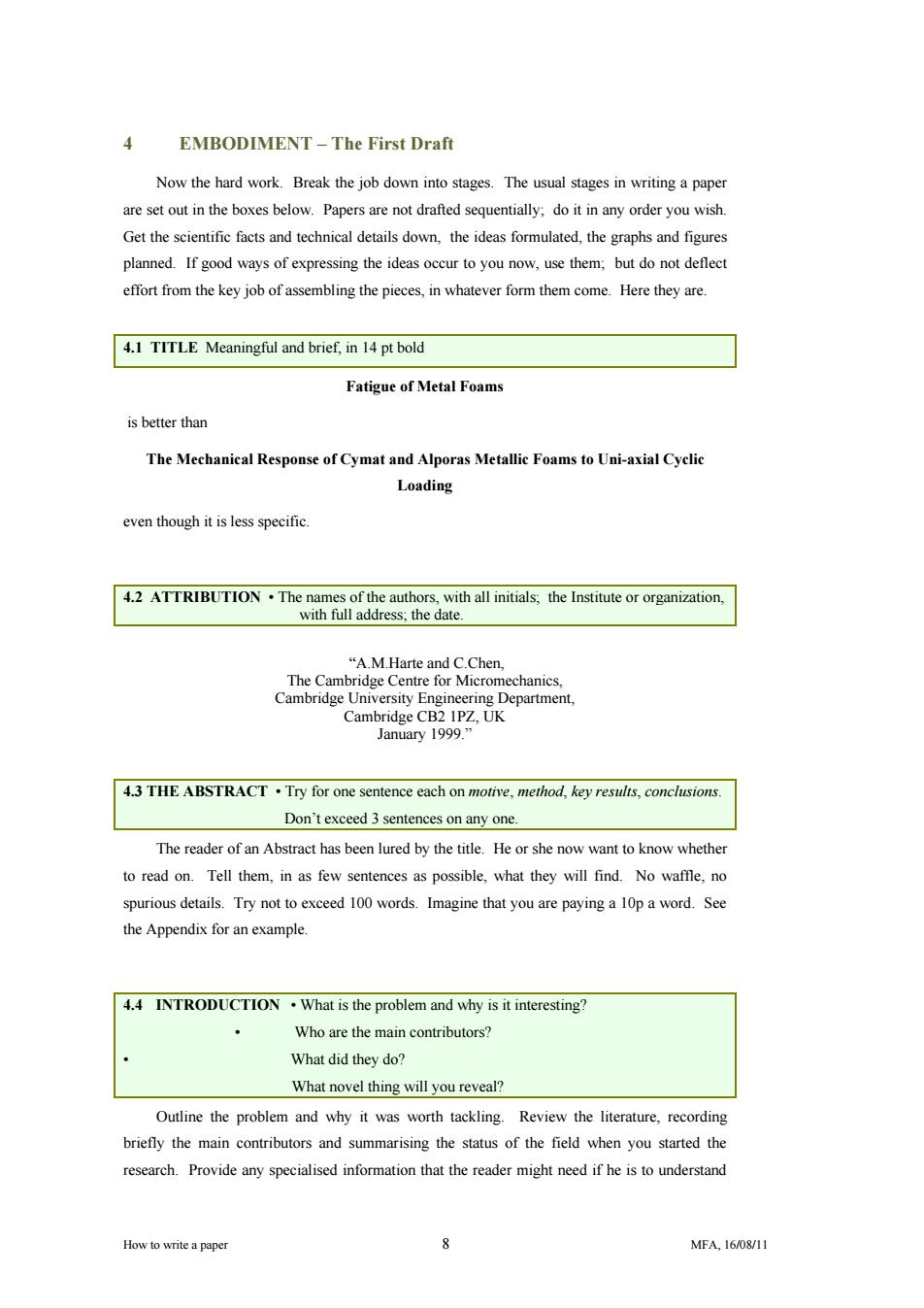正在加载图片...

4 EMBODIMENT-The First Draft Now the hard work.Break the job down into stages.The usual stages in writing a paper are set out in the boxes below.Papers are not drafted sequentially;do it in any order you wish. Get the scientific facts and technical details down,the ideas formulated,the graphs and figures planned.If good ways of expressing the ideas occur to you now,use them;but do not deflect effort from the key job of assembling the pieces,in whatever form them come.Here they are 4.1 TITLE Meaningful and brief,in 14 pt bold Fatigue of Metal Foams is better than The Mechanical Response of Cymat and Alporas Metallic Foams to Uni-axial Cyclic Loading even though it is less specific. 4.2 ATTRIBUTION.The names of the authors,with all initials;the Institute or organization, with full address;the date. “AM.Harte and C.Chen, The Cambridge Centre for Micromechanics, Cambridge University Engineering Department, Cambridge CB2 IPZ,UK January1999.” 4.3 THE ABSTRACT.Try for one sentence each on motive,method,key results,conclusions. Don't exceed 3 sentences on any one. The reader of an Abstract has been lured by the title.He or she now want to know whether to read on.Tell them,in as few sentences as possible,what they will find.No waffle,no spurious details.Try not to exceed 100 words.Imagine that you are paying a 10p a word.See the Appendix for an example. 4.4 INTRODUCTION What is the problem and why is it interesting? Who are the main contributors? What did they do? What novel thing will you reveal? Outline the problem and why it was worth tackling.Review the literature,recording briefly the main contributors and summarising the status of the field when you started the research.Provide any specialised information that the reader might need if he is to understand How to write a paper 8 MFA,16/08/11How to write a paper 8 MFA, 16/08/11 4 EMBODIMENT – The First Draft Now the hard work. Break the job down into stages. The usual stages in writing a paper are set out in the boxes below. Papers are not drafted sequentially; do it in any order you wish. Get the scientific facts and technical details down, the ideas formulated, the graphs and figures planned. If good ways of expressing the ideas occur to you now, use them; but do not deflect effort from the key job of assembling the pieces, in whatever form them come. Here they are. 4.1 TITLE Meaningful and brief, in 14 pt bold Fatigue of Metal Foams is better than The Mechanical Response of Cymat and Alporas Metallic Foams to Uni-axial Cyclic Loading even though it is less specific. 4.2 ATTRIBUTION • The names of the authors, with all initials; the Institute or organization, with full address; the date. “A.M.Harte and C.Chen, The Cambridge Centre for Micromechanics, Cambridge University Engineering Department, Cambridge CB2 1PZ, UK January 1999.” 4.3 THE ABSTRACT • Try for one sentence each on motive, method, key results, conclusions. Don’t exceed 3 sentences on any one. The reader of an Abstract has been lured by the title. He or she now want to know whether to read on. Tell them, in as few sentences as possible, what they will find. No waffle, no spurious details. Try not to exceed 100 words. Imagine that you are paying a 10p a word. See the Appendix for an example. 4.4 INTRODUCTION • What is the problem and why is it interesting? • Who are the main contributors? • What did they do? What novel thing will you reveal? Outline the problem and why it was worth tackling. Review the literature, recording briefly the main contributors and summarising the status of the field when you started the research. Provide any specialised information that the reader might need if he is to understand